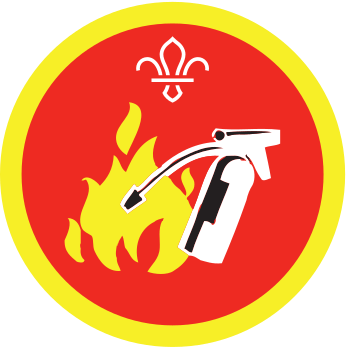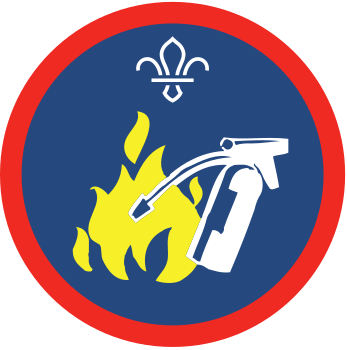Plan a fire escape route
You’ll need
- Obstacles
- Blindfolds
Before you begin
- Use the safety checklist to help you plan and risk assess your activity. Additional help to carry out your risk assessment, including examples.
- Make sure all young people and adults involved in the activity know how to take part safely.
- Make sure you’ll have enough adult helpers. You may need some parents and carers to help if you’re short on helpers.
Planning and setting up this activity
- Learning about fires can be traumatic, distressing and scary, especially for younger children or those who have previously experienced fires. You may need to offer reassurance for anyone who is nervous, upset or unsure. Always follow the Yellow Card.
- This activity’s about learning the skills to be safe in the unlikely event of a fire. People should leave feeling empowered and confident, not anxious or scared. Make sure you have time to chat at the end. Let people know that there are many people working hard to keep them safe. Though the first time they hear the fire alarm or talk about fire safety, they may be scared, it’s important to practice knowing what to do and how to behave in an emergency situation, so we can be prepared do it calmly and know what to do if we need to.
- Always let people know about running this activity in advance and give people the chance to let you know if they’re not comfortable taking part. You may need to avoid a particular scenario or make other adjustments, such as letting everyone know they can stop at any time if they don’t want to carry on. They could take a break at any point and you could have a safe space for them to use. Always follow the Yellow Card.
- Make sure you’re staying safe. Find out more about fire safety in Scouts and managing a Safe Scouts premises for fire safety.
Running this activity
Learn what to do
- Gather everyone together and ask if anyone knows anything about fire safety.
- Ask if anyone knows what to do if they discover a fire in their home. Explain and make sure everyone understands what to do if they discover a fire. We’ve added some safety tips to this page.
Practise an escape
- Everyone should get into pairs or groups of three.
- Each team should use furniture and other items in their meeting place to build suitable and safe obstacles around the room, which may delay you during a fire escape. It’s up to them what they use, such as tables, chairs, cones or boxes. Just make sure not to use anything that’s could break easily or hurt anyone. Always keep any real fire exits clear.
- When everyone’s ready, the teams should spread out around the room.
- Mark out a spot that shows teams where need to reach as a fire exit. It could be a cone, a door or an actual fire exit. Depending on the number of teams, you may want to have different end points for each team. You could also just go from one side of the meeting place to the other.
- From where they're standing, everyone should plan an escape route in their heads. Where are they going? What do they need to avoid? How will they get there?
- The first person in each team should put on a blindfold or close their eyes, depending on which they prefer. They should try to navigate the route they’ve planned while keeping low to the ground, just like they would if the room were filled with smoke.
- Everyone else in the team should make sure the person doesn’t bump into anything. They could offer directions if the blindfolded person gets stuck.
- Once they reach the exit, the person can take off their blindfold and celebrate their safe escape.
- Everyone should return to where they were standing in step two, and repeat the activity with someone else being blindfolded.
- Once everyone’s had a turn, tidy up the obstacles, so the space is clear.
- People should try to navigate an escape route while blindfolded again. Was it easier or harder to get out when there weren’t obstacles in the way?
Plan your escape
- Now, give out pens and paper. Everyone should imagine the layout of their home. They could draw it out if that helps them to visualise it.
- People should create an escape plan for themselves and the people they live with. How would they get out if there were a fire?
- Everyone should take their escape plans home and share them with the people they live with. They could talk about fire safety, share what they’ve learned, or plan and practice escaping their home in an emergency. They could also practice doing it in the dark or test their smoke alarm at home, so everyone knows what it sounds like.
- Stay calm and raise the alarm: Shout, set off the fire alarm, or bang on doors. If it is safe to do so, check rooms and get everyone together.
- Check before opening the door: Feel doors with the back of your hand before you open them, if they’re warm, don’t open them – the fire is on the other side.
- If you can leave, get out quickly: Don’t delay to save valuables or look for pets, and don’t investigate the fire.
- Shut doors behind you if you can: As you go out, only open the doors you need to and close any open doors you can to slow the spread of the fire.
- Avoid lifts: If you’re in a building with lifts, always use the stairs.
- Try to stay together: If you’re escaping with others, stay together if you can.
- Stay close to the floor: If there’s smoke, keep low to the ground and crawl, as this is where the air is clearer. On the floor, put your nose as low as possible – remember, smoke is toxic and can kill you.
- Call 999: Call 999 once you’ve left the building or if you’re trapped. Give your whole address, including the town, and tell them what’s on fire, such as ‘a two-storey house’. Explain if anyone is trapped and what room they’re in – give as much information as you can so they can help you.
- Stay outside: Stay out of the building until the fire service say you can return. Most buildings have an assembly point to meet at if there’s a fire. If there isn’t one, stay clear of the fire, but go somewhere you’ll be noticed when the fire service arrives.
- If someone is still inside: If there's someone still inside, stay outside and never go back into the building. Tell 999 while on the phone and wait for the Fire and Rescue Service to arrive. You can tell them about the person and they will be able to find them quicker than you. If you go back into the building, you will slow down the firefighters efforts to rescue anyone else missing – and put your own life in danger.
- If your escape room is blocked: If you’re trapped in a room or in a building, call 999 and stuff pillows or sheets around the bottom of the door to stop smoke getting in. Open a window, stay low to the ground, and shout and wave something to show the emergency services where you are. The air at floor level is clearest.
This guidance is taken from Humberside Fire and Rescue Service.
Reflection
This activity was all about developing the skills to stay safe in an emergency situation. What’s the most important thing people learned in this activity? People’s answers will be different depending on what they already knew – but the most important thing to remember in a fire is to stay calm and raise the alarm.
Knowing how to act in an emergency is an essential skill and it could even save lives. Why is it important to have a clear plan (even if it seems really obvious)? Obstacles and decreased vision can make it seem trickier, and it’s also easier to stay calm if you’re following a plan you made before the emergency began.
Everyone should make sure that the people they live with know what to do in an emergency and that exits and walkways are kept clear.
Safety
All activities must be safely managed. You must complete a thorough risk assessment and take appropriate steps to reduce risk. Use the safety checklist to help you plan and risk assess your activity. Always get approval for the activity, and have suitable supervision and an InTouch process.
- Heavy and awkward objects
Never lift or move heavy or awkward items alone. Ask for help or, if possible, break them down into smaller parts.
- Dark
Provide some light, so the environment isn’t completely dark. Everyone must be able to see others and move around the area safely.
- Active games
The game area should be free of hazards. Explain the rules of the game clearly and have a clear way to communicate that the game must stop when needed. Take a look at our guidance on running active games safely.
- To make this activity easier, you could make the obstacles easier.
- To make this activity harder, you could add extra obstacles halfway through an escape attempt – perhaps an area (or an exit) is now out of bounds because the fire’s spread. This reminds everyone how important it is to have a Plan B in case their main escape route isn’t safe, and gives everyone a chance to practise different scenarios.
- If anyone in your group has access needs (or knows anyone who does), chat about what you’d do to keep them safe if there were a fire.
- Fire alarms can be noisy. Make sure anyone who’s sensitive to noise knows in advance if you’re going to use them and ask what would help them. You may wish to provide ear defenders.
All Scout activities should be inclusive and accessible.

